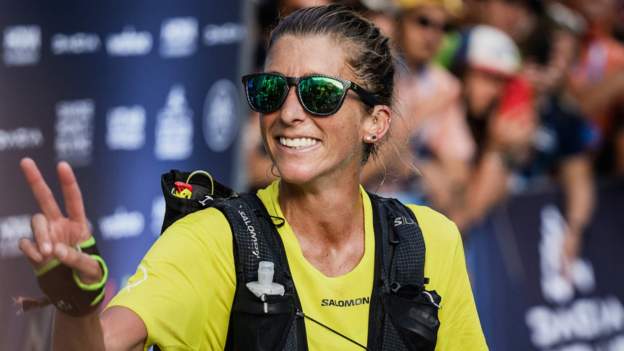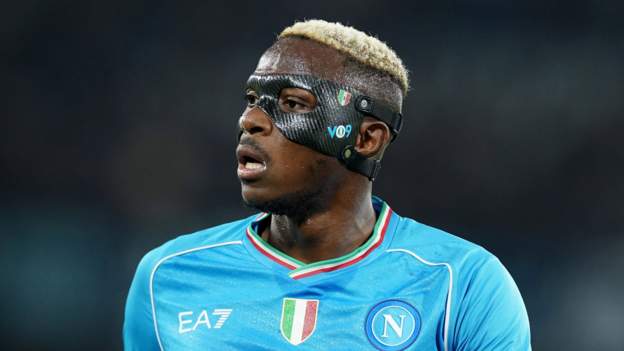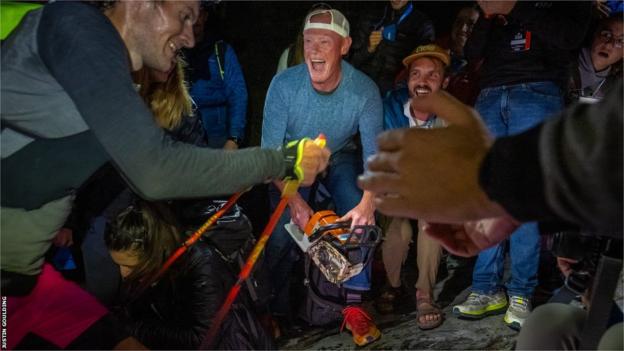
It is just past 9pm on a cool summer evening at the foot of a steep hiking path in the French Alps.
A place to savour the tranquillity of nature, inhale the fresh mountain air and marvel at a sky dotted with more stars than you could even begin to count.
Not tonight.
House music is pumping, the air is thick with red flare smoke and a man who may well have auditioned for Nightmare on Elm Street is revving a chainsaw to within an inch of its life.
Eyes bulging, face glistening with sweat and a maniacal grin across his face as petrol leaks to the ground and fumes fill the nostrils, he is among the thousands of people lining the track at Notre Dame de la Gorge just outside the small town of Les Contamines-Montjoie.
Hundreds rattle cow bells like toddlers with a new toy. Others rely simply on the power of applause. Everyone is roaring encouragement. Fortunately, Monsieur Chainsaw has had the good grace to leave the blade at home.
Through this tunnel of noise strides a grinning Courtney Dauwalter, the greatest female ultra-runner in the world and 20 miles into the biggest, most famous and wildest trail race on the planet.
Welcome to Ultra Trail du Mont Blanc, a race so epic it has been described as the World Cup, Tour de France and Super Bowl of running. None of those does it justice.
UTMB covers 106 miles, starting and finishing in Chamonix and passing through three countries – France, Italy and Switzerland – as it circumnavigates Mont Blanc, the highest mountain in Europe.
The distance is only half the story. Runners must tackle 10,000m of elevation gain – comfortably more than the height of Everest – cope with temperatures ranging from below zero to 30C, and handle any conditions thrown at them by mountains which are normally the preserve of skiers. Helicopter search-and-rescue insurance is compulsory.
The race follows a popular hiking route that usually takes 10 days. The elite runners at UTMB charge round in under 20 hours. Mere mortals have two days to ‘complete the loop’.
Earlier this month, 2,689 athletes from 81 countries set off on one of the toughest challenges of their lives. More than a third didn’t manage it, and many of those who did were a physical and mental wreck by the time they staggered over one of the most iconic finish lines in sport.
Jez Bragg, the only male British winner of UTMB – in 2010, describes it as “the perfect journey – I love it to bits”. Four-time winner and trail-running legend Francois d’Haene says: “What is magical is the winner and the finisher can have the same feeling – ‘wow, we made it’.”
There are so many aspects of UTMB that are special in their own right.
Let’s start with the scenery. Chamonix, nestled in a slim valley and flanked by towering peaks and awesome glaciers that rise steeply from the end of people’s back gardens, is breathtakingly dramatic. And it only gets better during the race, with stunning views of the snow-capped dome of Mont Blanc. “The beauty is insane,” says Bragg. “There’s nowhere else like it.”
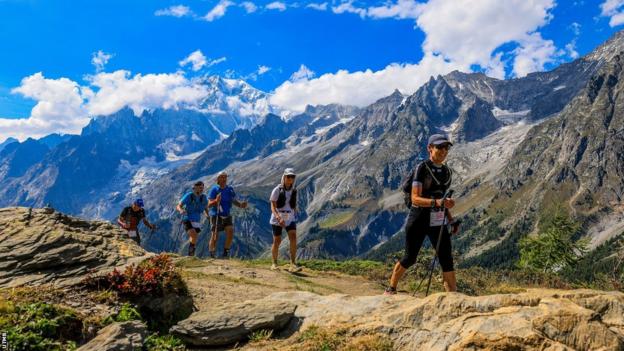
Then there’s the scale. The second most prestigious 100-mile trail race in the world, Western States in California, caps entry at fewer than 400 runners, a fraction of UTMB. Over the course of a week in Chamonix, 10,000 people take part in a series of races that culminate in UTMB, with the help of 2,500 volunteers from all over France and beyond.
The atmosphere is the stuff of legend. Crowds five deep line the streets of Chamonix; the riotous scenes from Notre Dame de la Gorge are repeated in countless other villages; and fans camp out at even the most remote parts of the UTMB course in the middle of the night to cheer on what amount to little more than moving headlamps. Britain’s Tom Evans, who finished third in 2022 and is among the favourites this year, describes it as “completely bonkers”.
The quality of the field is also beyond compare. “It’s the most competitive race of the whole year and they’re all in the shape of their life,” according to American Dylan Bowman, who finished seventh in 2017 and now hosts the Freetrail podcast. “It definitely is the one to win,” says Evans, despite his stunning triumph at Western States in June. Katie Schide, women’s UTMB champion in 2022, says simply: “You don’t use UTMB as a training race.”
Throw in the fact this year is the 20th anniversary of the event, mixed with huge dollops of drama courtesy of the organisers’ slick promotional and marketing machine, and it is clear why Bowman says UTMB is “orders of magnitude bigger than anything else” in trail running.
Trail running is essentially running anywhere off-road, but typically involves hills (UTMB’s hills tend to be bigger than most). It is one of the fastest growing sports in the world and Chamonix, which hosted the Winter Olympics in 1924, is widely acknowledged as its summer home – at least in Europe.
There is no better example of that than the UTMB start line. All the runners cram into the Place de l’Eglise in front of the town hall, not an inch of road visible amid a swarm of bright running kit and twitching muscles.
Shops shut before the Friday 6pm start, timed so the leading runners finish during the busiest part of Saturday afternoon. Spectators and photographers reserve their spots hours in advance. Some clamber on statues for a better view. If you can see beyond a mass of outstretched arms and mobile phones, you’re one of the lucky ones.
Vangelis’ Conquest of Paradise, the operatic soundtrack to a Ridley Scott movie, bounces off the walls in the narrow street, ratcheting the tension to fever pitch before the starting gun fires.
“The atmosphere is like nothing I’ve ever experienced – in any sporting event,” says Bragg. “It’s a unique hype, excitement and anxiety – extremes of emotions – even before you’ve left Chamonix. The crowd are trying to transfer their energy to the runners, and the runners are living in fear of what lies ahead.”
The elites, who share the same start line as the amateurs but are allowed a spot at the front, sprint off at a speed more suitable for a 10km race than 170km, to avoid being stuck in a bottleneck as the road narrows.
“You hear stories of people falling,” says Schide. “So the first 800m you’re not thinking of pacing – you’re thinking ‘get out and find space’. You’re just trying not to trip up on anything.”


Schide is not racing UTMB this year – she finished second in a 34-mile race in Chamonix earlier in the week – and fellow American Dauwalter is the clear favourite in the women’s field.
UTMB champion in 2019 and 2021, Dauwalter is chasing the unprecedented Triple Crown of 100-milers in 2023, having won Western States and Hardrock, in Colorado, this summer. Only a handful of top runners have even attempted three of the most brutal ultra-marathons in the running calendar in the space of 10 weeks. Completing them is almost unbelievable, winning them borderline ludicrous.
“It would be one of the biggest achievements in the history of the sport, and something that will never be repeated,” says Bowman. “Courtney is a once-in-a-generation athlete.”
Dauwalter, 38, has transcended the niche world of ultra-running, her carefree attitude, perma-smile – especially when racing – and baggy shorts as much a part of her appeal as her phenomenal athletic accomplishments.
She holds the female record at Western States, Hardrock and UTMB; she has not been beaten by a woman in any race since 2019; she routinely finishes in the top 10 regardless of gender; and she once won a 240-mile race outright. As a guest on Joe Rogan’s podcast and a cover star in the New York Times sports section, she is on the verge of household-name status in the US.
Schide is candid enough to admit Dauwalter is in a league of her own. “We’re not even close to competing,” she says. “Courtney doesn’t race anyone – she just runs and kills us all.”
Evans says: “In order for me to win, I need to be at 100%. Courtney needs to be at 75%. The other girls are amazing, but she is an absolute specimen.”

The phenomenon that UTMB has become is a far cry from the low-key affair that was organised from a living room in 2003. Repeatedly pestered by a friend into creating a race around Mont Blanc, husband and wife Michel and Catherine Poletti eventually gave in.
Their daughter Isabelle built a website. Teenage son David was among the volunteers. Michel’s sisters and Isabelle’s father-in-law served as the medical team.
The Polettis expected 300 runners. In the end, 722 signed up. “That was emotional, the first start,” says Michel, who also ran the race. “At 4am in the morning, there was no crowd.”
Armed with a mobile phone, two radios and a laptop under a gazebo, Catherine and a handful of volunteers were race HQ. A mere 67 runners completed the circuit, less than a 10% finish rate in miserable conditions.
Michel ran part of the race with American Krissy Moehl, who was on her honeymoon – a wedding present from the sports shoe company she worked for. At the same time her new husband, Brandon Sybrowsky, was being welcomed over the finish line by Catherine as the joint second-place finisher.
“This was their honeymoon – me with Brandon and Michel with Krissy,” remembers Catherine. “It could be a movie,” chuckles Michel. Moehl, who was the first female finisher, says: “The French loved it. They went to town on the romantic couple.”
Thanks to Michel’s organising prowess and Catherine’s business savvy, UTMB grew exponentially. In 2006, when the race sold out in three weeks, the Polettis began adding events of varying distances to cope with demand. UTMB tickets were snapped up in nine minutes in 2008, a qualification process was introduced in 2009 and a lottery system the following year.
Catherine says as many as 9,000 people apply for a UTMB race bib each year. Michel reckons that, without the current system whereby hopefuls must collect ‘running stones’ by completing qualifying events, “it could be 100,000”.
“It has changed so much,” says Dawa Sherpa, winner of the men’s race in 2003 despite never having run more than 70 miles. “But that first race is like yesterday in my mind.”
Moehl, now 45 and a running coach, triumphed again in 2009. “UTMB has a special place in my running career. But it’s only in hindsight. I didn’t know it then,” she says.
The winner’s prize in 2003 was no more than a wooden trophy. Bragg, now 42, remembers scooping some sports vouchers in 2010 before returning to his job as a chartered surveyor.
Did life change in any way? “Not at all. You’re back in the lift on Tuesday morning, making small talk on the way into the office. I could never be bothered trying to explain to people because 90% just wouldn’t get it.”
Although this year’s winners will each collect 10,000 euros (£8,600), victory is worth much more in terms of sponsorship and profile.
“It makes it easier to explain to a sponsor that’s not totally inside the sport,” says 31-year-old Schide. “You can just say, ‘Hi, I’m Katie, I won UTMB’, and not, ‘Hi, I’m Katie, I was second at this race in Italy’.
“I live in a tiny village in France and it doesn’t change my life at all. It’s not like people are stopping us in the street.”

By the time Dauwalter is dodging chainsaws at Notre Dame de la Gorge she is at the head of the women’s field by a few seconds. She stretches that lead to 18 minutes in Courmayeur in Italy, the midway point of the race after 53 miles and one of the crucial aid stations.
For many runners this will be a first opportunity to get help from their support crew – only one person is allowed to help at a handful of checkpoints throughout the race.
Tactics vary. The majority of competitors refuel and rest, but Dauwalter, arriving at 3:40am after almost 10 hours on the go, is in and out within two minutes – and that includes brushing her teeth.
Jim Walmsley, the leader of the men’s race, passed through this aid station – essentially a sports hall with picnic tables – more than an hour ago, only seconds ahead of fellow American Zach Miller.
Quietly spoken and somewhat awkward in front of the camera, Walmsley has been described as an alpha male on the trail, dominating races from the front.
Already an ultra-running legend at the age of 33, his CV is bursting with major victories, including three – and a course record – at Western States. He also holds the 50-mile world record of four hours 50 minutes.
Before any of those achievements, Walmsley was perhaps best known as the man who led the 2016 Western States for 93 miles before taking a wrong turn, ending up on a highway and finishing 20th. His faux pas was immortalised in the film ‘Found on 49’.
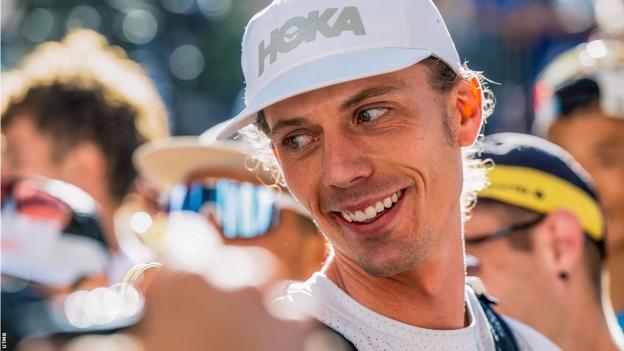
UTMB continues to elude him, though. He was fifth in 2017, did not finish in 2018 and 2021, and last year led for two-thirds of the race before fading to fifth.
This year, with Spaniard Kilian Jornet – widely acknowledged as the greatest trail runner of all time and a four-time UTMB champion – absent through injury, could be Walmsley’s best chance.
Such is his obsession with winning UTMB that last summer he and his wife Jess moved from Arizona to Areches, a small village close to the race route. He lives down the road from close friend and training partner D’Haene, who won the most recent of his four titles in 2021.
“I really hope Jim can win it. For him it would be so nice,” says D’Haene. “But maybe he will never win UTMB. It’s not the most important thing. Maybe in 10 years it’s more important what he has experienced here in the mountains.”
No-one seems to know before the race what shape Walmsley is in. He tore ankle ligaments in May, missed the Mountain and Trail Running World Championships in June and has been suspiciously silent on Strava in the weeks leading up to UTMB.

Chamonix and trail running are as inextricably linked as cheese and wine in France.
Every other shop in the town centre sells sports gear. The streets are full of bulging quads and granite calves that would make England footballer Jack Grealish jealous. And there can’t be many places in the world where the hotel chef wears running kit while on duty, all the quicker to get on the trails once the breakfast shift finishes.
“The people are genuine enthusiasts – they get it. There’s an Alpine spirit and so much respect for the competitors,” says Bragg, who won UTMB despite the altitude limitations of living in Warwick at the time.
This comes at a price. Runners who are anonymous at home will be mobbed in Chamonix. “For 10 days in the calendar year you become an A-list celebrity,” says 31-year-old Evans, who left triathlete wife Sophie Coldwell in charge of their four chickens, two dogs and tortoise during his pre-race training camp in the Alps.
As a Frenchman living in the area, even the affable D’Haene says: “You can get tired if you have 200 selfies a day and cannot walk one metre.”
Schide agrees. “We are all people who spend a lot of time alone, then we’re suddenly in these really intense situations with a ton of people around.
“It can be exhausting. The first time I did UTMB in 2019, I didn’t do a good job of managing my energy, and when I got to the start line I was thinking, ‘I just want this to be over’. You don’t want to feel like that at the start of a 100-miler.”
Coping with the extra attention and pressure is one part of a UTMB puzzle that can take many of the top runners years to solve, if at all.
Winners require a “way bigger toolbox” than at most races, according to Evans, who spent eight years in the Army and ran his first ultra in 2017 after a drunken bet with friends in the pub.
“It’s very important that you have everything,” says D’Haene. “You have to cope with the mountains, the night, hiking. You have to run fast on the flat, you have to be OK on technical terrain, in steep descents, runnable descents.”
Completing a 100-mile race of any nature requires a rather special relationship with pain – physical and mental.
Dauwalter, a science teacher before turning professional in 2017, uses races as an opportunity to chisel at her “pain cave”.
“For me it’s normal,” says 37-year-old D’Haene, who has done so many UTMB loops in training that he has lost count. “Of course it’s difficult. Of course you get tired. You are destroyed. But even if it’s horrible pain, I love it. People pay to do that. People wait for three years to do that. They choose it. Why complain?”

Evans’ race ends amid some pain in Courmayeur. Part of a lead pack with Walmsley and Miller for much of the first 50 miles, he drifts off the pace and ends up spending 10 hours in an Italian hospital. “UTMB… see you next year,” he writes on Instagram a few days later.
Miller makes his move in the next phase of the race, overtaking a struggling Walmsley as they head for Switzerland.
Like Walmsley, UTMB is the itch Miller wants to scratch: he has three top-10s since 2016 without finishing higher than fifth.
Sporting his trademark moustache and a trucker’s cap on back to front, even when racing, the 29-year-old is one of the most distinctive and popular figures in the sport.

He spent five years as a caretaker in a hiking cabin in the Colorado mountains and now travels around the US in a converted Breaking Bad-style bus, turning up at races to give out free doughnuts and ice lollies.
There are reports that Miller was picking up litter during this year’s UTMB, and only a few hours after the race he is walking round Chamonix buying cheese with his girlfriend.
His tactics are endearingly gung-ho, running hard from the off and hoping to cling on. “The fans really love the aggressive style, but all the coaches and sponsors are like, ‘maybe you should start conservatively’. I’m kind of stuck with it now,” he grins.
When Miller reaches Champex-Lac, 79 miles into the race, he has a 12-minute buffer over Walmsley, who is even briefly passed by Frenchman Germain Grangier, the eventual third-place finisher.
Dauwalter, stopping briefly to embrace her husband and parents by the roadside, is on course to break her own UTMB record and is so far in front of the women’s field that only a seismic collapse can stop her.

All these precious moments are captured on camera. Indeed, coverage of the race is almost as astounding as the athletic performances.
UTMB is streamed live in a choice of seven languages thanks to a mixture of drones, helicopters and, most impressively, runners and e-bikers who somehow manage to film the leading protagonists while keeping pace with them.
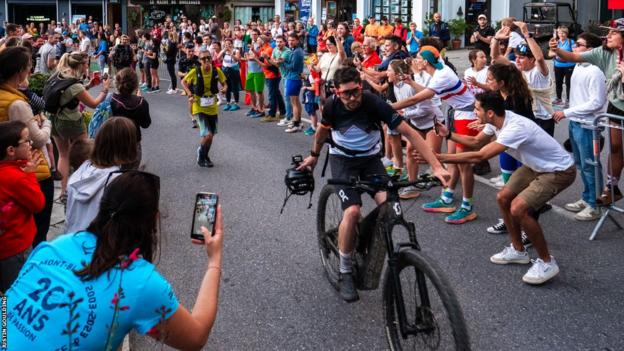
Runners will often come into view at aid stations surrounded by a moving gaggle of videographers. Body language is scrutinised by eagle-eyed commentators. Dozens of zoom lens are trained on athletes as they do something as exciting as eat a banana or change a T-shirt. In 2019, viewers got a close-up view of Dauwalter vomiting live on TV.
There’s definitely a market for it. UTMB had 52 million video views on its official website and social media channels during the week of racing this year. Some 436 journalists were accredited and almost 2,000 articles published, double the 2022 figure.
Lizzy Hawker’s mother had no such luxury in 2005. She rang the tourist information office in Chamonix the day after UTMB to discover her daughter had won the race – the first of a record five victories for one of Britain’s all-time great runners.
Yet the growth of UTMB is not to everyone’s taste.
At its heart, trail running is a simple sport rooted in community. The top runners, largely untouched by layers of management, remain approachable and willing to share their love of the trails. In how many other sports can you high-five the best in the world as they go about the business?
The Polettis have dedicated their lives to UTMB and genuinely love what they do. Michel, who was born in Chamonix and convinced Catherine to move there after they met at university in Grenoble, has completed the race seven times, most recently last year at the age of 67. He will make it 25 miles into this year’s loop before being timed out.
Isabelle has taken over from Catherine as race director, while David runs an app which provides live updates from all corners of the course. Catherine is on the finish line to welcome the winner of every race.
However, UTMB is now part-owned by the behemoth that is Ironman Group and has been criticised for decisions such as introducing a qualifying process that incentivises people to sign up for – and spend money on – more races.
A UTMB entry alone costs 355 euros (£300), and that’s before you consider travelling to and staying in one of the most expensive resorts in Europe. “It’s too big now. It smells of money,” says 53-year-old Dawa, who was born in Nepal but has worked as a bricklayer in Geneva for 25 years.
“A lot of people are protective about the grassroots,” says 37-year-old Bowman, who started racing ultras in 2009. “UTMB in Chamonix is unapologetically about the spectacle, the brands and the commerce around it. There’s a tension, for sure.”
Schide, one of the minority of runners who is fully professional, says: “We’re asking for more prize money, more support, more doping control. At the same time we don’t want money in the sport. It’s a huge point of contention.”
UTMB’s green credentials have also been criticised. Damian Hall, one of Britain’s leading trail runners, fifth-place finisher in 2018 and vocal climate activist, is among those who have boycotted the race while it is sponsored by a car manufacturer.
Michel Poletti acknowledges that UTMB has a “huge responsibility” to limit the impact on the environment and is “fighting to find a solution”, but says: “Our carbon footprint all week is the same as one day of the Tour de France.”

Dauwalter has just stopped to hug an inflatable pizza. Moments later she will be pursued by a topless man riding a blow-up dinosaur and carrying a loudspeaker. Fancy dress appears to be mandatory at Col de la Forclaz, where at times Dauwalter has to force her way through a crowd of delirious supporters blocking the path.
“My ears were ringing,” she says later. “To all of the insane fans out on course today, thank you so much. That was one of the coolest things I’ve ever experienced.”
Walmsley, the adopted Frenchman, also feels the love. “This year more than any other, the ‘Allez Jim’ was off the charts. It definitely felt like a home race.”
With his “stomach and legs back in the game” after “falling apart”, Walmsley turns a 12-minute deficit to Miller into a healthy lead in the process of crossing the Swiss-French border. That cushion is never threatened and he can afford to enjoy the descent into Chamonix.
There he is roared through town by many of the same fans who sent the runners on their way the previous day, leaning precariously over the barriers for the final mile to try to get a glimpse of the first American man to win UTMB.

A wobbly legged Walmsley, a tired smile spreading across his face, crosses the finish line in 19 hours 37 minutes amid a cacophony of cheers, applause, music and a pumped-up race announcer.
His UTMB mission complete, he collapses into the arms of his wife. The tears soon follow.
Miller arrives 21 minutes later to a stupendous roar, sprinting down the finishing chute in trademark fashion and pointing at Walmsley as a mark of respect as he crosses the line. He too breaks the hallowed 20-hour mark.
There are not many events in which athletes are offered a chair for their post-race interview. But UTMB is not like most events. Asked how he feels after claiming arguably the greatest win of his career, Walmsley replies: “Terrible. I’ve felt terrible for a while.”
The following day, riding his bike around Chamonix between various media commitments, he expands on that. “There’s joy, relief, a lot of things coming together. It’s a special moment of a lot of hard work organising my life to accomplish this goal.
“I get to join the strong US women’s contingent. They’ve done it again and again here and I’m just happy to stand on their shoulders.”
One of those women will cross the line herself almost four hours later.
Dauwalter labours through the final third of the race, barely able to pick up her feet at times and the smile long since replaced by a vacant stare. But, in her own words, she wills herself to the finish.
Her entrance on to Place de l’Eglise brings by far the loudest cheer of the day – the crowd know they are witnessing one of the greatest of all time make history. UTMB’s Instagram reel of that moment has been watched 1.1 million times.

“This was totally crazy and really, really difficult – but worth it,” says a visibly drained Dauwalter, moments before being taken to the medical tent for treatment.
The next day she admits she is still “destroyed”. “My legs are sad and throbbing and my brain is unwilling to do difficult things,” she says. “I had run out of energy and I was deep in my pain cave. No matter how hard I was chiselling at it, it wasn’t translating to power.”
It begs the obvious question: why put yourself through such physical and mental punishment?
“My motivation for the sport is never about a finish place or finish time,” says Dauwalter. “What are we capable of? What can humans do? I want to test that as much as possible.
“Our brains and our bodies are incredible, and when we sync them up and put them towards one cause, it’s pretty cool what we can find out about ourselves.
“This is the thing that fires me up. My hope is that all people can find the thing that fires them up in the same way.”
Every single one of the 1,757 finishers at UTMB has their own motivation. Every single one is cheered home, day or night. Every single one has a story to tell.
There is China’s Fu-Zhao Xiang, the fourth-placed female whose boyfriend proposes on the finish line. And Claude Sevin, jogging the final stretch to become this year’s oldest finisher at 70.
Or fellow Frenchman Philippe Tran, his contorted body in spasm and leaning to the left, staggering in with his family propping him up. After 106 savage miles and two nights in the mountains, he is the final finisher in 48hrs 16mins.
For him, Dauwalter’s words surely ring true: “Any time we’re given the opportunity to try something difficult or crazy, we should absolutely take it.”










